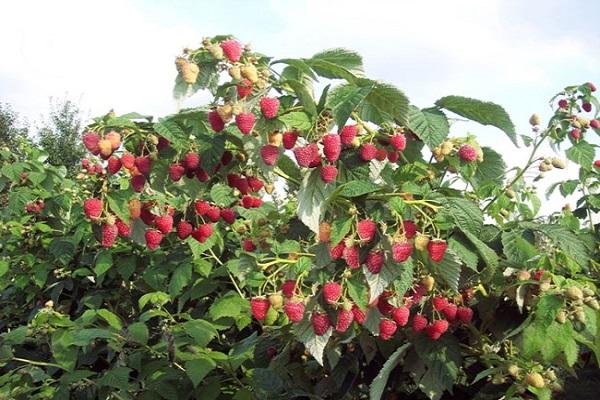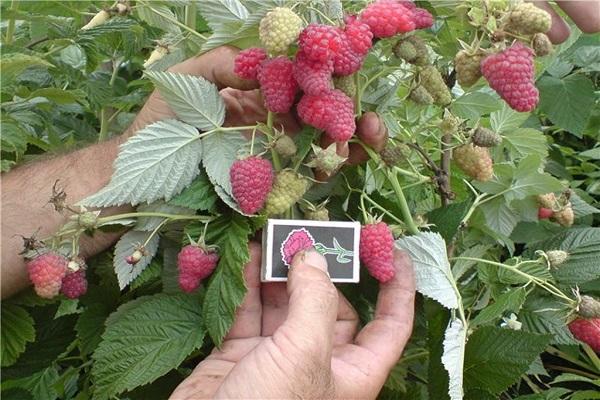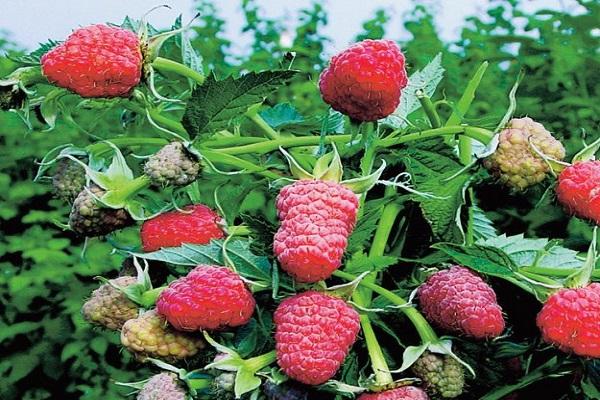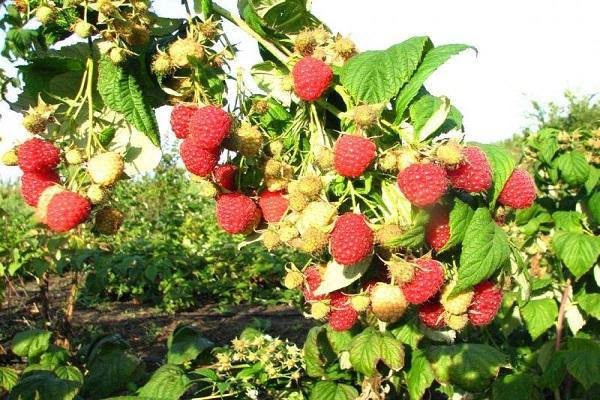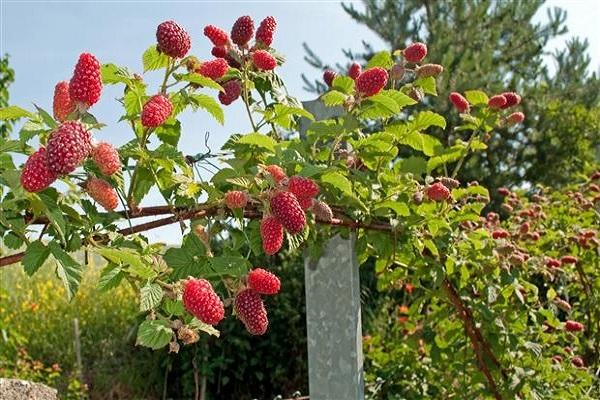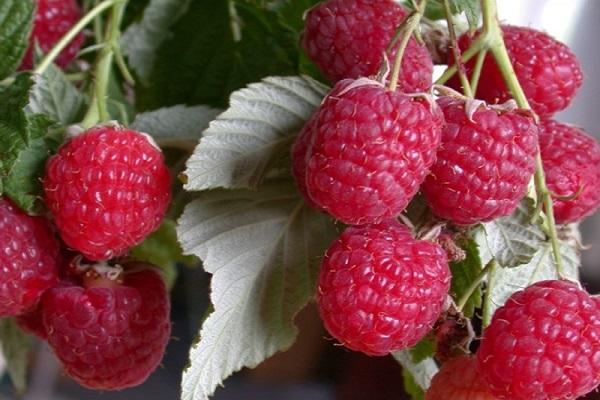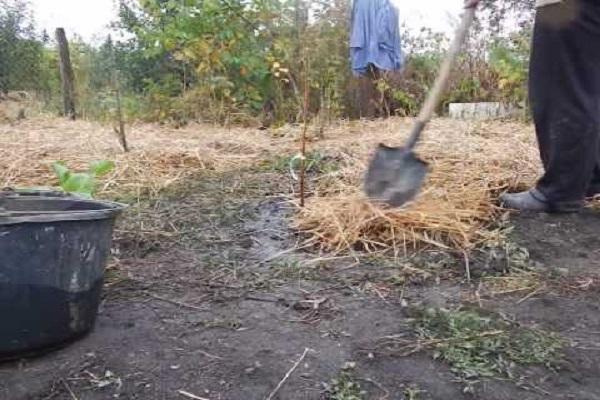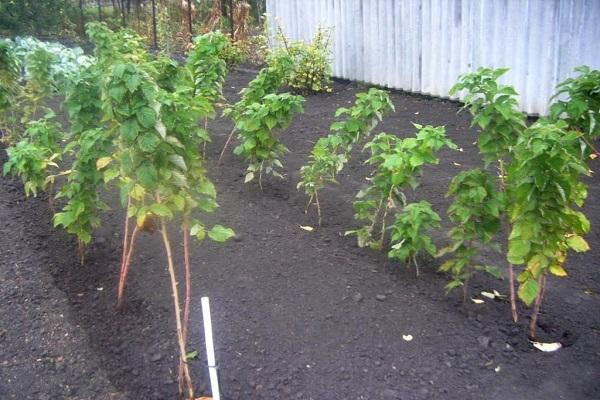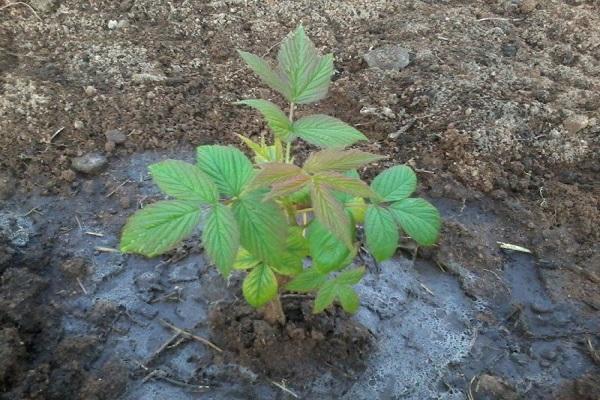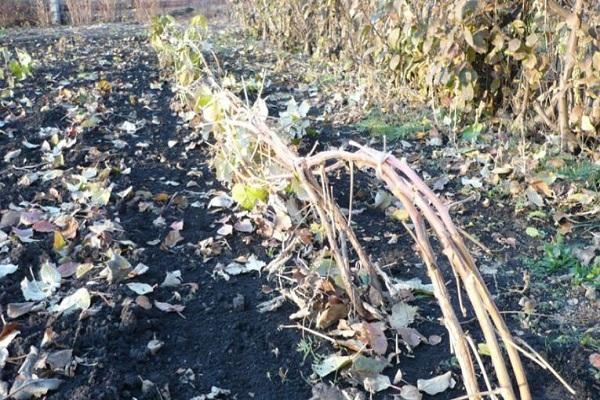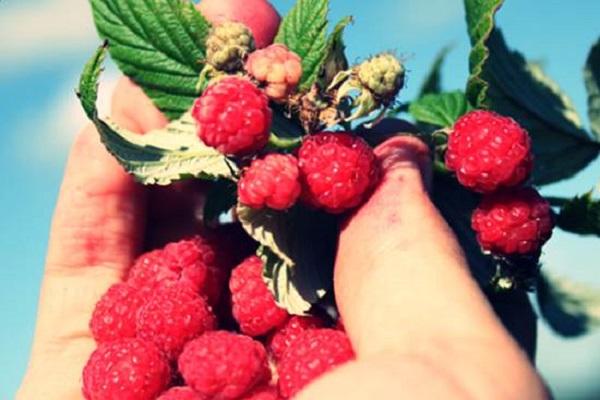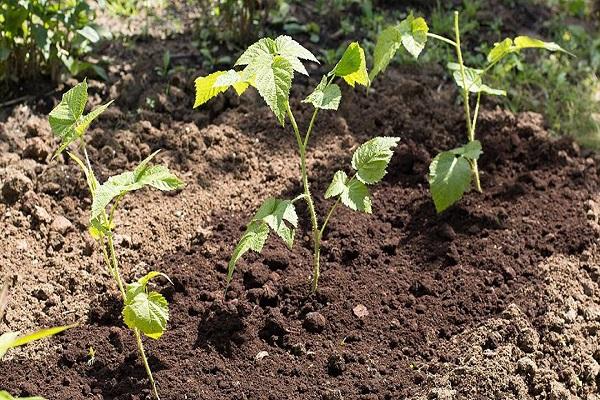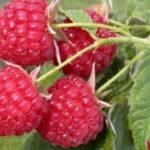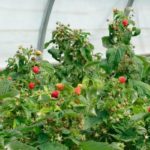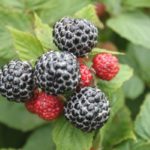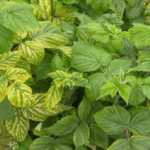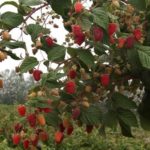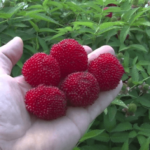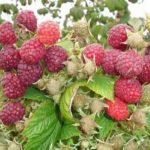Tarusa is a raspberry, the description of which is more similar to that of a tree. In fact, this crop is a perennial shrub. However, the tree-like stem of this plant reaches a height of almost 2 meters. At the bottom of the bush there are no side branches; they appear only at a distance of 50 centimeters from the ground. This feature is the reason that Tarusa bushes are often confused with a tree.
- History of culture development
- Advantages and main disadvantages
- Description of the standard raspberry variety Tarusa
- Appearance of the bush
- Features of flowering and pollination
- Yield and berry characteristics
- Technical features of the “raspberry tree”
- Frost resistance and drought resistance
- Disease and insect resistance
- How to plant a variety on a plot
- Best disembarkation time
- Preparing planting holes and seedlings
- Technology and schemes for planting bushes
- Cultivation care
- Formation and garter of the bush
- Watering
- Fertilizer application
- Preparing for winter
- Treatment against diseases and pests
- Ripening and harvesting
- Raspberry propagation methods
- The best varieties of standard raspberries
History of culture development
Tree raspberry Tarusa became the first varietal crop that grew not on the usual bushes, but on a raspberry tree. Although this is the same shrub, only with a long, woody, erect stem. Such plants are called standard plants. The name comes from the word “bole”, which means part of the stem, from the root collar to the beginning of the crown.
Tarusa is a standard, but not remontant crop, bred by the Soviet breeder V.V. Kichin. The variety was obtained by crossing the domestic Stolichnaya raspberry and the large-fruited Scottish Shtambovy-1.
From the Scottish parent, the new variety inherited the large size of the berries and the ability to produce a bountiful harvest. From the domestic variety, the Tarusa standard raspberry received resistance to frosty winters and various diseases. Since 1993, the culture has been available for free sale and has slowly begun to win the love of summer residents. The berry got its name from the name of the city of Tarusa, which is located in the Kaluga region.
Advantages and main disadvantages
Tarusa raspberries have their strengths and weaknesses. When properly cultivated, the crop produces a good harvest. If there are errors in agricultural technology, the berries also ripen, but become small and sour.
Pros:
- the berries are large and sweet;
- high productivity;
- there are no thorns on the stem;
- excellent winter hardiness;
- resistance to diseases and insects.
Minuses:
- due to genetic mutations, the berries sometimes become small;
- in the rainy season the fruits are sour and watery;
- the crop is tall and needs support;
- the tree needs to be insulated for the winter;
- after harvesting, the berries are stored for no more than a week and cannot be transported;
- the crop is affected by insects and needs to be treated with insecticides.
Description of the standard raspberry variety Tarusa
The culture is standard. Tarusa has a two-year fruiting cycle. Two-year-old stems that have produced their entire harvest are cut off at the end of the season. New shoots are formed to replace the cut branches.
Appearance of the bush
Tarusa has a thickened, long and rigid stem. The plant, although it does not require support, but if there are trellises, it produces a larger harvest of sweet berries. The lower part of the stem is freed from branches. Starting from the middle of the trunk, release the side branches. A dozen branches can grow on one stem. They can reach a length of 0.5 meters. This feature gives the bush the appearance of a small tree. The bushes themselves are low, the stem length is about 1.5 meters. The culture is not remontant.
The plant grows upward. The bush does not spread across the garden plot. Annual stems are straight, hard, tough. There are no thorns on the shoots; they are covered with a light felt coating, as well as a slight waxy coating. Fruiting branches have about three branches. They are durable and not very long. Each branch produces about 20 berries.
In the area from 50 to 120 centimeters from the ground, many laterals are formed. These twigs covered with fruits look like a belt of berries. The bush has large, corrugated dark green leaves.
Features of flowering and pollination
Raspberries bloom from mid-June. The berries ripen in July, although not at the same time. Tarusa has bisexual flowers. The culture is self-fertile and does not require pollinators.In the case of cross-pollination by bees, the number of berries only increases.
Yield and berry characteristics
Tarusa has large berries, weighing up to 12 grams, with small drupes. They have a regular triangular shape, bright red color, and shiny surface. The berries are dense and easily removed from the fruit. The fruits are sweet in taste, tender, juicy, with pulp that melts in your mouth. The seeds are small, almost imperceptible. It is possible to collect 4.55 kilograms of sweet harvest from the bush. With timely application of organic matter, the yield almost doubles.
Technical features of the “raspberry tree”
Tarusa is a specially bred variety according to specified criteria. Raspberries tolerate continental winters well; in the spring they quickly come to life and begin to grow.
Frost resistance and drought resistance
Tarusa has moderate winter hardiness. The bush does not freeze in regions where winter temperatures drop to 30 degrees. If winter frosts exceed this mark, the bushes are bent closer to the ground and insulated. It is better to bend the stems at the end of September, when they are not dry and brittle. Tarusa does not like rainy weather and tolerates drought well. In dry summers, its berries become sweeter.
Disease and insect resistance
The culture is resistant to many diseases. However, even in the presence of diseases, raspberries do not lose their qualities and do not stop bearing fruit. The main pest of Tarusa is considered to be aphids. To combat these insects, insecticides (Aktellik, Karbofos) are used. The bushes are treated with preparations before flowering begins.
How to plant a variety on a plot
Tarusa is an unpretentious plant. Raspberries are easy to grow in your garden. It is advisable to buy seedlings from specialized nurseries. Before planting, you need to choose a place where the bush will feel great.Tarusa loves well-lit areas. You can plant raspberries along the beds, near low hedges.
It is recommended to plant raspberry bushes away from strawberries, potatoes and tomatoes. These crops suffer from the same diseases as raspberries, they can increase the likelihood of infection of neighboring plants. Tarusa prefers loam, sandy loam soil, and black soil. The earth should be neutral and slightly acidic. The crop does not tolerate waterlogged soil.
Best disembarkation time
Tarusa is planted in spring, autumn or summer. After spring planting, the bushes begin to bear fruit only the next year. Plants are planted early in the spring, even before the buds awaken. This method guarantees complete adaptation of the crop to the climatic characteristics of the region. In autumn, raspberries are planted in September, 2 months before the onset of frost.
The plant needs time to take root in a new place and get a little stronger. Bushes planted in autumn bear fruit the following summer.
Preparing planting holes and seedlings
A month before planting, the soil in the garden plot is prepared. The earth is dug up, fertilized with rotted humus (0.5 buckets per bush), minerals (superphosphate, potassium sulfate - 30 grams of each). If the soil is acidic, then add 500 grams of wood ash, lime or dolomite flour. If the land is fertilized with organic matter, nitrogen fertilizers are not applied.
Raspberry bushes are planted in holes or long dug trenches. The dug hole should have a depth of 50 centimeters. The distance to the neighboring plant is 0.5-1 meter. Before planting, the stems on the bush are cut to 40 centimeters. The roots of the plant are placed for 10 hours in a solution of Kornevin or Heteroauxin.
The plant is lowered into the hole and the roots are covered with fertilized soil up to the root collar. Then the bush is watered abundantly.After watering, the ground can be mulched with dry bark.
Technology and schemes for planting bushes
Raspberries are planted using bush or strip methods. With the bush method, separate holes are dug at a distance of 1 meter from each other. With the tape method, they dig a trench 50 centimeters wide and deep. The planting scheme is as follows: young seedlings are immersed at a distance of 40 centimeters from each other, and then sprinkled with fertilized soil.
Cultivation care
After planting, the tree needs to be looked after. Tarusa raspberries require regular care and timely application of fertilizers.
Formation and garter of the bush
It is important to ensure that the plant produces more side shoots. It is advisable to pinch the tops of the bushes. This technique will lead to the formation of additional side branches. With good care you can get 10 shoots. Thanks to this agricultural technology, by the end of the first season the standard bush will look like a young tree. Productivity will increase significantly only in the second year.
Raspberries are a tree whose cultivation and care always brings the desired result.
Watering
If the weather is too dry in spring and summer, water the raspberries twice a week. The soil should be well saturated with moisture. It is advisable to pour at least 10 liters of water under one bush. Moisture will not evaporate much if the soil is first mulched with dry grass or bark.
Fertilizer application
Organic and mineral additives are added to the soil just before planting raspberries. Then, every spring, the bushes are fertilized with mullein solution, phosphorus and potassium fertilizers. To reduce acidity, add 500 grams of wood ash to the soil. Mineral and organic supplements are not applied at one time, they are alternated.Raspberry bushes can be fertilized with nettle infusion. During fruit formation, complex fertilizers (Kemira-Lux, Ryazanochka) are applied at the root.
Preparing for winter
Before wintering, the bushes are trimmed a little, the top and side stems are trimmed by 20 centimeters. Be sure to get rid of old and diseased branches and prune them. In late autumn, while the stems of the plant are not dry, they are bent to the ground. Before the cold winter, plants can be wrapped in agrofibre.
Treatment against diseases and pests
Raspberries are often attacked by insects. Bushes in the spring, before the berries appear, are treated with insecticides. Main pests: raspberry beetle, gall midge, aphid, weevil. The following chemicals protect against insects: Actellik, Alatar, Iskra-M.
Raspberries can suffer from purple spot, powdery mildew, and anthracnose. To prevent diseases, bushes are sprayed with Bordeaux mixture, Hom, copper oxychloride, Abiga-Peak. The crop will not get sick if you care for it properly, remove diseased twigs and leaves in a timely manner, mulch the soil, and use exclusively healthy planting material.
For disinfection, the plant is sprayed and watered with a solution of copper sulfate or the drug Fitosporin-M.
Ripening and harvesting
The culture is considered mid-late. The berries ripen on July 10. The number of harvests is up to 5 times. The crop completes fruiting in August. The berries are collected as they ripen. Otherwise, the raspberries will crumble. It is advisable to pick berries during the day, in dry weather. If raspberries are picked together with the stalk, they will be stored longer. The berries are eaten fresh or made into jams, juices, and preserves.
Raspberry propagation methods
How Tarusa raspberry propagates:
- dividing the bush;
- root cuttings;
- root shoots.
Raspberries propagate by dividing the bush extremely rarely. With this method, the bush needs to be dug up and divided into parts. Raspberries are usually propagated by root cuttings. Preliminarily dig in the mother plant. A root with dormant buds is removed from the ground. It is cut into cuttings. Each division must have roots. The cuttings are pre-germinated in a nutrient soil mixture. When the stems appear, the plants are transplanted to a permanent location.
For propagation by shoots, the creeping roots along with the stems formed on them are separated from the mother plant. They are immediately planted in a permanent place. Root shoots can be replanted all summer long.
The best varieties of standard raspberries
In addition to Tarusa, there are other standard crops - Krepysh, Skazka, Bogatyr, Galaxy. In these crops the stem reaches a height of 2 meters. There are no thorns on it. The largest berries are from the Skazka variety (15 grams), the smallest are from the Galaxy variety (6 grams).
All crops are winter-hardy, rarely get sick, and produce few root shoots. The fairy tale begins to bear fruit at the end of July; 6 kilograms of harvest can be collected from one plant. From a bush of the Galaxy variety you can collect 10 kilograms of sweet berries.

